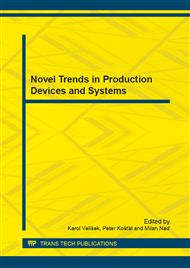p.279
p.285
p.291
p.297
p.303
p.309
p.315
p.321
p.327
The Size of the Friction Coefficient Depending on the Size and Course of Normal Load
Abstract:
The coefficient of friction for the bronze material (CuZn25Al6) with inset graphite beds is investigated in the present paper. Friction coefficient was investigated experimentally by the testing machine Tribotestor`89 which uses the principle of the ring on ring method. Tribotestor`89 machine may be classed to the rotary tribometers. The tested sliding pairs were of the same material. The internal bushing performed a rotational movement with constant sliding speed (v = 0.8 m s-1). The external fixed bushing was exposed to the normal load, which was of different sizes and different variations. Process of load was increased from level 50 N to 200 N (400 N, 600 N) during run up 600 s, after the run up the appropriate level of load was held.The forth test had a rectangular shape of loading with direct current component 400 N and the amplitude 200 N period 600 s, the whole test took 1800 s. The obtained results reveal that friction coefficient decreases with the increase of normal load. Further, that the coefficient of friction was found smaller at constant load, as compared to rectangular shape of loading.
Info:
Periodical:
Pages:
303-308
Citation:
Online since:
January 2014
Authors:
Price:
Сopyright:
© 2014 Trans Tech Publications Ltd. All Rights Reserved
Share:
Citation:


